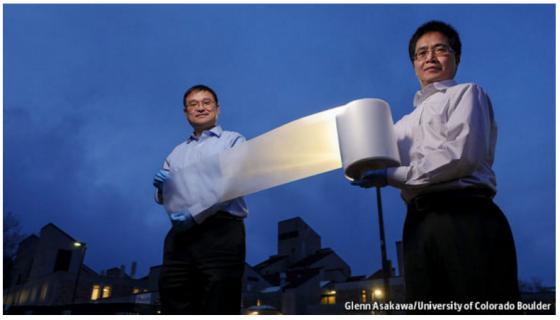Green Building Community
A film worth watching: How to keep cool without costing the Earth?
Posted by: Kalyani.rc // Passive House / Sustainability Enthusiast

About 6% of the electricity generated in America is used to power air-conditioning systems that cool homes and offices. As countries such as Brazil, China and India grow richer, they will surely do likewise. Not only is that expensive for customers, it also raises emissions of greenhouse gases in the form both of carbon dioxide from burning power-station fuel and of the hydrofluorocarbons air conditioners used as refrigerants.
Dr. Ronggui Yang and Dr. Xiaobo Yin of the University of Colorado, in Boulder, have a possible alternative to all this. They have invented a film that can cool buildings without the use of refrigerants and, remarkably, without drawing any power to do so. Better yet, this film can be made using standard roll-to-roll manufacturing methods at a cost of around 50 cents a square metre.
The new film works by a process called radiative cooling. This takes advantage of that fact that Earth’s atmosphere allows certain wavelengths of heat-carrying infrared radiation to escape into space unimpeded. Convert unwanted heat into infrared of the correct wavelength, then, and you can dump it into the cosmos with no come back.
Dr Yang’s and Dr Yin’s film, is made of polymethylpentene, a commercially available, transparent plastic sold under the brand name TPX. Into this they mixed tiny glass beads. They then drew the result out into sheets about 50 millionths of a metre (microns) thick, and silvered those sheets on one side. When laid out on a roof, the silver side is underneath. Incident sunlight is thus reflected back through the plastic, which stops it heating the building below.
Preventing something warming up is not, though, the same as cooling it. The key to doing this is the glass beads. Temperature maintenance is not a static process. All objects both absorb and emit heat all the time, and the emissions are generally in the form of infrared radiation. In the case of the beads, the wavelength of this radiation is determined by their diameter. Handily, those with a diameter of about eight microns emit predominantly at wavelengths which pass straight through the infrared “window” in the atmosphere. Since the source of the heat that turns into this infrared is, in part, the building below, the effect is to cool the building.
That cooling effect, 93 watts per square metre in direct sunlight, and more at night, is potent. The team estimates that 20 square metres of their film, placed atop an average American house, would be enough to keep the internal temperature at 20°C on a day when it was 37°C outside.
To read on, please click:
http://www.economist.com/news/science-and-technology/21716599-film-worth-watching-how-keep-cool-without-costing-earth
Please be kind and respectful!
Please make sure to be respectful of the organizations and companies, and other Rate It Green members that make up our community. We welcome praise and advice and even criticism but all posted content and ratings should be constructive in nature. For guidance on what constitutes suitable content on the Rate It Green site, please refer to the User Agreement and Site Rules.
The opinions, comments, ratings and all content posted by member on the Rate It Green website are the comments and opinions of the individual members who posts them only and do not necessarily reflect the views or policies or policies of Rate It Green. Rate It Green Team Members will monitor posted content for unsuitable content, but we also ask for the participation of community members in helping to keep the site a comfortable and open public forum of ideas. Please email all questions and concerns to admin@rateitgreen.com

